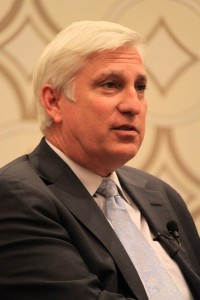The March 2014 edition of The Planning Report features Jeff Kightlinger discussing how Metropolitan’s efforts after the 1990s drought led to changes that are paying off in the extreme dry conditions the state is experiencing this year, Celeste Cantu discussing the difference between 20th and 21st century water management mindsets, and Australia’s Adam Lovell shares his country’s new focus on customer service and urban stormwater capture.
 Water in the age of uncertainty: Jeff Kightlinger on how Metropolitan has prepared for drought
Water in the age of uncertainty: Jeff Kightlinger on how Metropolitan has prepared for drought
At the recent conference, Water in the Age of Uncertainty: A Southern California Response to Climate Change, hosted by the Council for Watershed Health and Climate Resolve, General Manager Jeff Kightlinger gave an overview of Metropolitan’s efforts to drive down demand and increase water storage over the last three decades. In this speech, he speaks of how the drought of 1991 impacted the wholesaler, saying, “The difference between 1977 and 1991 is that we added another 6 million people to Southern California. Suddenly, we couldn’t afford to lose one chunk of supply for three or four years and say, ‘That’s okay—we still have the Colorado; we still have the Eastern Sierras.’ It was a new world for Metropolitan.” Read what Jeff Kightlinger has to say in The Planning Report by clicking here.
One Water One Watershed: Celeste Cantu on water management mindsets in the 20th and 21st centuries
The Santa Ana Watershed Project Authority’s Celeste Cantu has been breaking down silos and encouraging an integrated regional view to watershed management with the successful “One Water One Watershed” 2.0 program. In this interview, she draws the distinction between water management mindsets in the 20th and 21st centuries, exploring the resistance among some to adopt a management approach in line with nature. “The concept of One Water comes from a natural perspective,” says Cantu. “It’s the way the natural system works, and then we see how we fit into that. We take our lead from nature. It really reverses the control mechanism. A lot of people are very uncomfortable with that. They are unwilling to say, “Yes, I’ll work in a consistent fashion with nature.” I personally think nature’s going to win most of the time and will ultimately always win. It just seems more effective to look at that system and respect it, as opposed to imposing our configurations on nature. But, that’s the rub. People are not comfortable doing that.” Read Celeste Cantu’s interview in The Planning Report by clicking here.
Australia’s new focus: Customer service and stormwater capture
At the US-Australian Dialogue on Water held at UCLA in January, Adam Lovell, Executive Director of the Water Services Association, gave a speech highlighting Australia’s extensive desalination and water-efficiency efforts over the last decade in response to unprecedented drought. He also the country’s discussed one of the country’s current water priorities—a focus on increasing customer service, saying “We have set out a new vision for urban water services in 2030, and that is customer-driven, enriching life. … This is a new way of thinking—it is about delivering customer services. And, it is about enriching life, because that recognizes the health that people expect from water supplies, and the healthy, livable communities that they expect from managing sewage services.” He also discussed how the country is working to capture urban stormwater. Read the full speech in The Planning Report by clicking here.
Full issue
The Planning Report is a trade publication featuring regional leaders on urban planning, growth, urban design, and public infrastructure investment. Read the full issue of the March 2014 The Planning Report by clicking here.
You must be logged in to post a comment.